(Written by William)
When I first heard about the #71374 LEGO Nintendo Entertainment System, I was really excited. I grew up with an original Nintendo and I had plenty of fond memories with it. Then I heard that the price was going to be $230, and I immediately grew less excited. Fortunately, my wife has gotten into enjoying her Nintendo Switch so she became rather interested in the set as a fan of Nintendo. That was enough of an excuse for me to pick it up for her for the holidays.
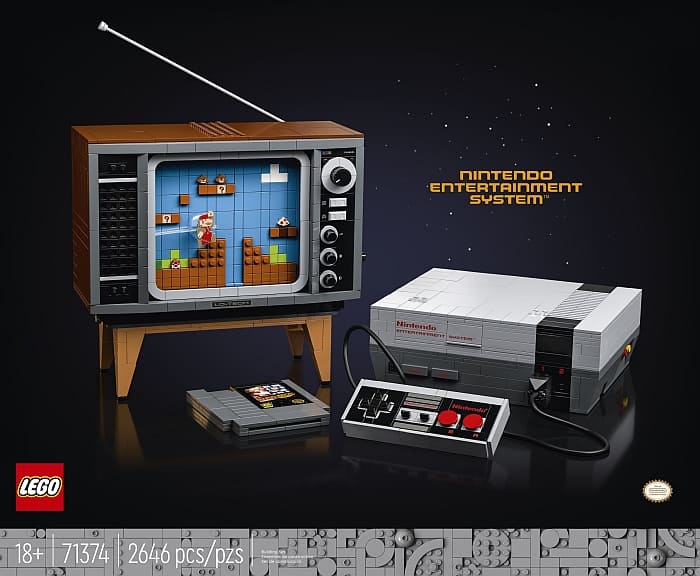
We had a building experience like none other, and this set definitely delivers; great building techniques, interesting mechanisms, tons of nostalgia, and fun to interact with despite the fact that it has no minifigures.
Among the features that impressed me the most was some of the spatial reasoning that went into creating minor details. Take, for instance, the front flap of the system. There is a slight ledge that helps you lift the lid in order to insert the game cartridge. That section alone has some of the most complicated piece arrangements I’ve ever seen. Brackets and tiles are suspended and nestled in all sorts of ways, all to have a tiny little lip on the flap of the console.
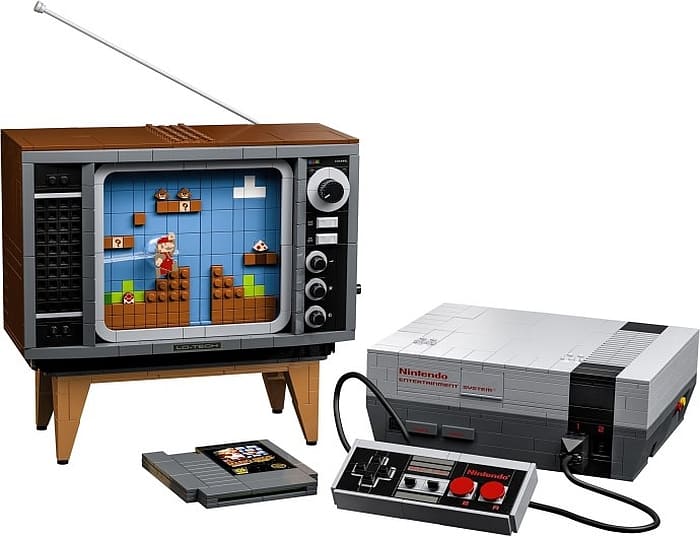
Another interesting point is the way LEGO designers used stickers in the model. Most of the printing is straight on the pieces themselves, however, the game cartridge and the back of the TV feature stickers. That’s because in real life, the equivalent objects had these stickers. In other words, stickers are there for authenticity and not as a shortcut for printing.
This is truly one of the most novel sets I’ve ever put together. And I sort of build a lot, so that’s a high bar to reach. I think a good method to showcase this novelty is to examine some of the more interesting techniques I learned about while building it. And I do mean learned about, since I had no clue how they could be accomplished before working with this model. In the video below, I will share more of my general thoughts about the set, then below it we will discuss some building techniques. So let’s get our retro on and take a look at what this system has to offer!
LEGO NES – Multi-Position Sliding Latch
I know this set was designed in such a way so original NES users will be swept away by nostalgia. And when in the designer-video the designers said that it featured the functionality of clicking a cartridge in place and then releasing the cartridge with the same action, I was definitely hooked! I kept imagining all the fancy ways that this could be accomplished, but truth be told, I had no idea how it could be done. I just knew that when I see it, I will have reconsider a lot of my knowledge on functional design. I definitely didn’t expect the mechanism to involve a sliding bar. But I’m getting ahead of myself. Let’s first point out a few important details that makes this all work.
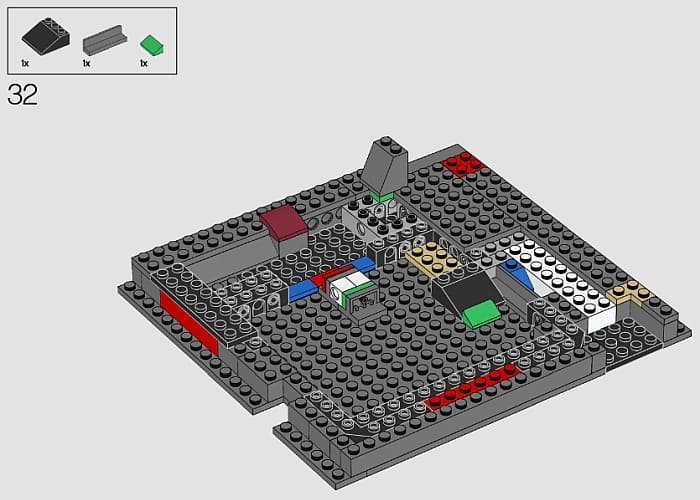
Starting off, we have the carriage that will hold the cartridge. It has three key features. First, it can tilt on a hinge you build using axles near the back on each side. Second, you have springs pushing it up from underneath giving that characteristic feel when pushing down on the front edge. And third, it has a section that’s entire purpose is to have a sliding bar latch. There’s even a little window cut out on the carriage so you can see the bar latch move.
Now let’s look at what this bar latch interacts with. At the bottom of the unit, we have two slopes. One large slope and one small slope that makes up the majority of what pushes the bar latch along. Suspended above these slopes is a modified plate with tiling and a small slope. This is angled to form a quasi multi-slope surface. Now that we’ve outlined the important parts, let’s talk about how this all works.
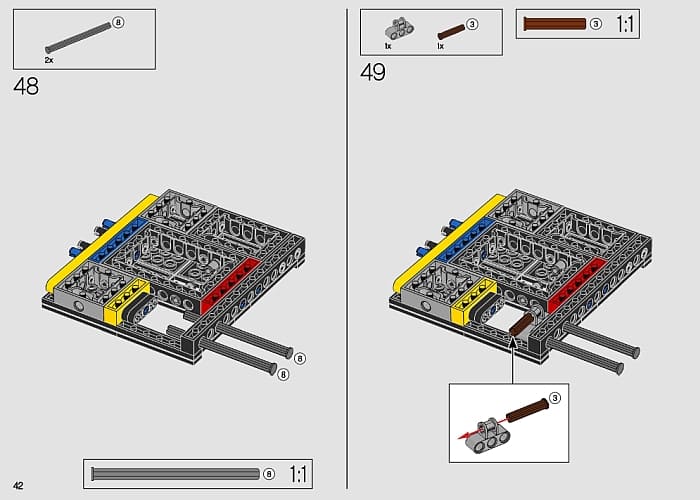
Pressing down on the carriage, the bar latch is moved forward, thanks to the large slope. However, the latch can’t reach the end since it runs into the back of the small slope. Now you release the carriage. Since the bar latch is only part of the way, it gets caught from above by the angled modified section. This new state puts the latch in a completely different position. It’s both forward from its original starting location and, due to the modified section being lower, it also locks the carriage in a down position.
Pressing down on the carriage again puts it in contact with the smaller slope on its angled side. Just like the large slope before, it pushes the bar latch forward again. By pushing this latch, it now has reached the end of where it can move. Releasing the carriage, it is now no longer under the modified section that caught it and locked it. Instead, it slips over this section and returns to its initial starting position. Thanks to this, the carriage is now in the up position.
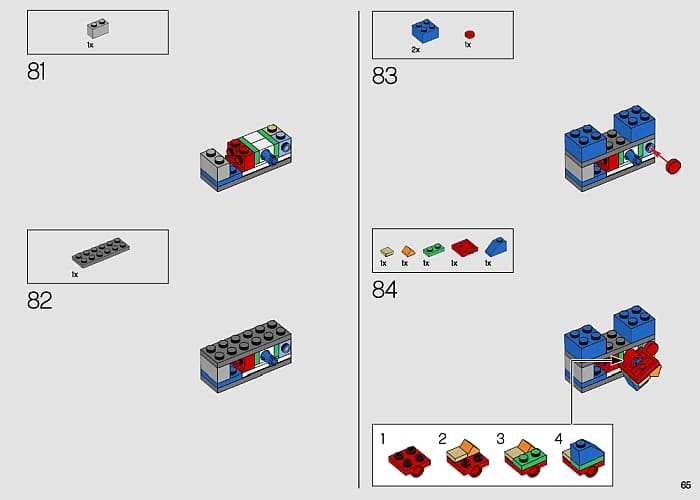
This can also be described as a bar being navigated between two sets of jagged teeth. Of course, it is also important to point out that gravity plays a massive role in how this works. If you turn the system upside down the bar latch will be in the wrong place to be manipulated by the slopes so it can’t latch.
I spent a lot of time playing with this mechanism. I know it is not meant to be the biggest play element in the set, but the novelty of the mechanism really is impressive. And as I mentioned before, I figured it would change how I think of functional mechanisms, and it definitely accomplished that.
LEGO NES – Rotating Canvas
When the #10246 LEGO Creator Detective’s Office was first released back in 2015, I learned that you can mount pieces to thread elements while building the water tower. However, I never thought to utilize this in a moving device. In the LEGO Nintendo Entertainment System, LEGO designers used the harder and much larger treads, which I only limited experience with. And they also used some modified 1×4 LEGO Technic plates with pins out the bottom that I’d never seen before. All of this added up to a very new building experience.
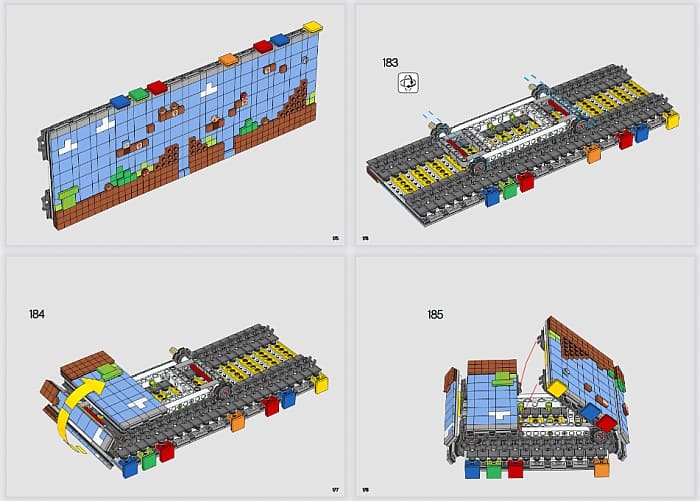
The idea behind the canvas is pretty simple. The larger you want it, the more belts of treads you want to use. On these belts, you attach long plate strips. You can then decorate these strips however you like. Mount all this on a frame with the appropriate gears, and it’s mostly done.
There are a few extra features to consider however so that you get the best result. First, to eliminate any snags or sagging, LEGO designers built a series of free-rolling wheels under the canvas. This reduces strain on the gears. Next, they framed the viewing area of the canvas. This allows only the best-looking parts of the scene to show through. Then they took it all one step further, which I was not expecting.
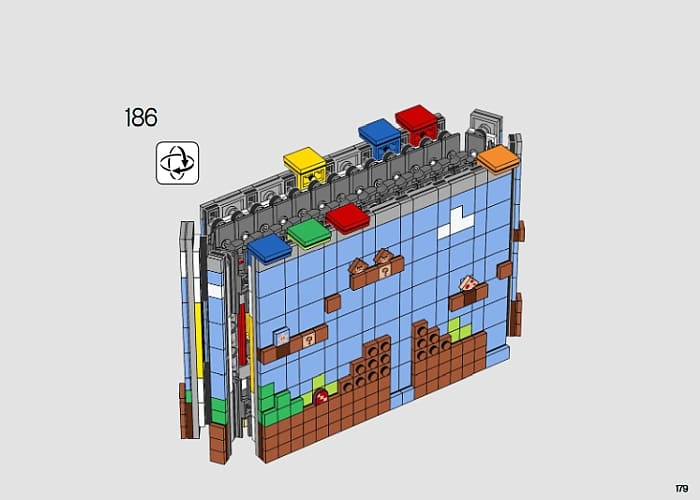
LEGO designers wanted to have the Mario character respond to the environment on the canvas. So behind Mario, there is a clear dish. As for the canvas itself, wherever they wanted Mario to jump, they introduced extra tiles or plates. This means, when the dish runs into these small obstacles, it follows the path of least resistance, making Mario look like he jumps. In other words, they made the normally decorative elements of the canvas to be functional as well.
LEGO NES – Sensory Building
I briefly touched on this technique when talking about the multi-position sliding latch and how good it felt to play with it. Generally, we focus on two aspects when building; the way our creation looks, and the way it functions. We even have two major systems within LEGO that excel at one of these two aspects; LEGO Systems always looks great, and nothing compares to the functionality of LEGO Technic. Even LEGO’s robot building kits rely heavily on Technic elements for their functionality. But what if I told you there are more things you can focus on.

This is where sensory building techniques come into play. The idea is to engage the senses beyond just sight. Now, I don’t recommend exploring tasting or smelling your bricks, but I want to point out that the way your build feels and sounds can be something to aspire towards.
The LEGO Nintendo Entertainment System has two distinct elements that cover these senses in ways I had never considered before. Pressing down to lock the cartridge in the machine and hearing an audible click is surprisingly satisfying. Additionally, the top knob on the television clicks and recreates the feeling of an old TV channel dial superbly. I was taken back to my childhood in a way I was not expecting.
I think much of this technique comes down to what you build rather than how you build. For instance, most of the time we build minifigure scaled models. These are then become objects we interact with in a rather abstract way. An example of this is a helicopter or catapult. Sure, they can fling boulders or have rotating propellers, but they’re more there to bring life to a minifigure world.
The LEGO Nintendo Entertainment System, on the other hand, is closer to a full-scale model. Its job is to recreate something we ourselves would have interacted with. Therefore, it needs to recreate sensations we associate with the objects that are being duplicated. An old TV needs to act like an old piece of technology. This includes messing with the antenna, finding all the ports, and learning to manually control all the buttons and dials.
The designers knew that not only should this set look in a certain way, but it needed to act in a rather specific manner as well. It was because of pursuing this goal that we ended up getting a set that doesn’t just appeal to our eyes, but also our senses of hearing and touch, and thus adding extra levels of authenticity.
Applying What You Learn
The multi-position sliding latch shows us how to create a latch that does not depend on circular motion. It also gives us a template on how differently this type of latch can work. Granted, it is highly dependent on gravity, but there is a ton of untapped potential in how it can be used.
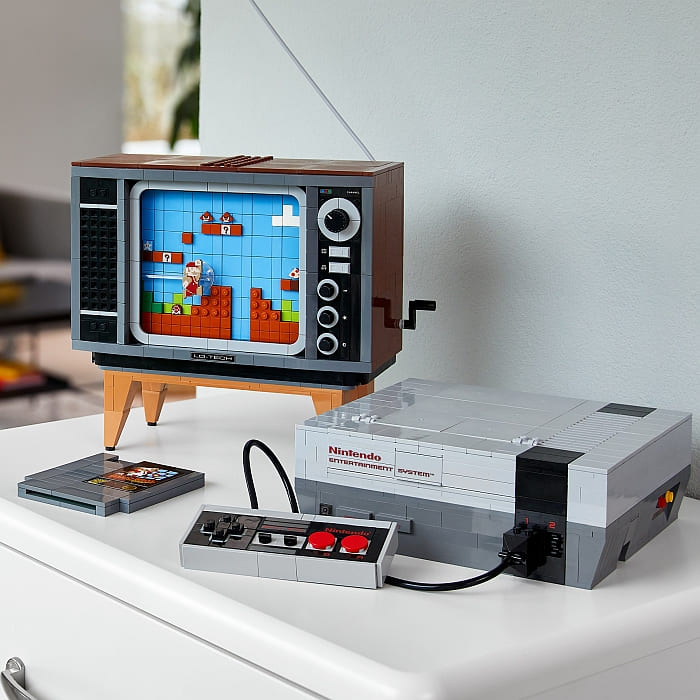
Speaking of untapped potential, a rotating canvas is a fascinating element of motion to explore. It can be used for something as simple as a moving sign, to something more elaborate like a shifting background. It’s also important to mention, that building this horizontally or vertically can expand the possibilities. It could even be interesting laid flat as flooring.
Finally, if we start making models that are meant for people and not just minifigures, there’s more ways to impress. Don’t stop with just how our model looks and works, but immerse people by really engaging their senses. Make them feel like they are messing with an actual “whatever” you created. Touch and sound are to great to focus on for this purpose. The end result will be nothing short of next level! If you don’t have the set yourself but would like to check it out, visit the LEGO Super Mario section of the Online LEGO Shop.
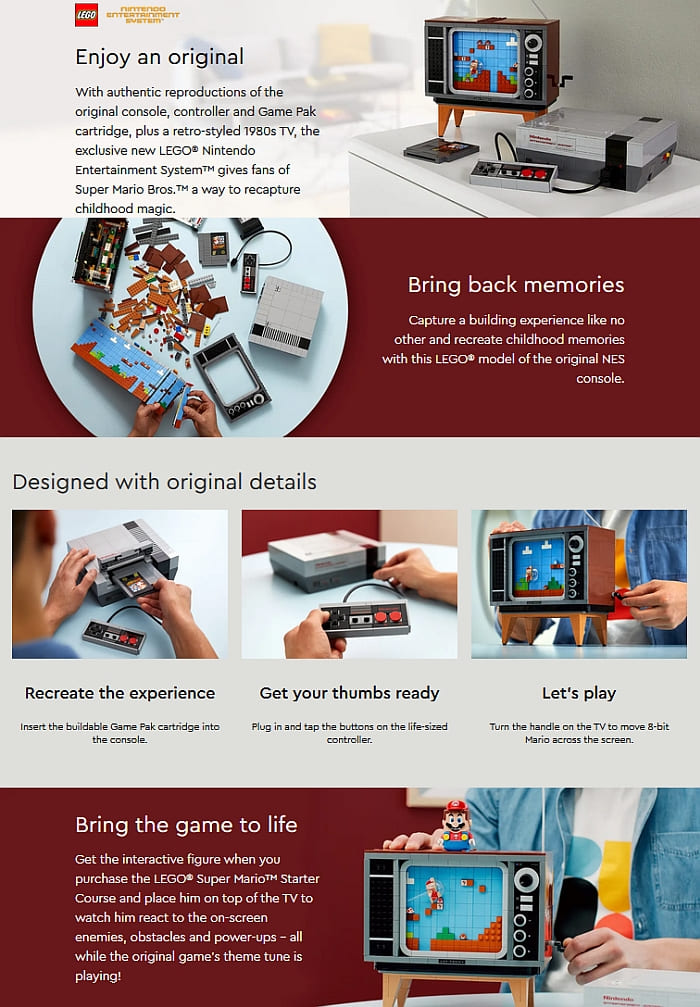
What do you think? How do you like the LEGO Nintendo Entertainment System? Do you have the set already? Or are you planning to get it? How do you like the building techniques we discussed here? Are there other techniques that really stood out for you? Feel free to share your thoughts and discuss in the comment section below!
And you might also like to check out the following related posts:












This is one of those sets that I would love to build, but I don’t know what I would do with it afterward. The building techniques look fascinating.
I would be very interested to build that rotating screen. I wonder what’s the smallest and largest scale it could be done.
Same here, I would love to see how the whole thing comes together.
The sensory building aspects are something I would have not thought of. At least not in so much detail. Incredible set.
The rotating canvas is genius and that clear dish makes it even more incredible. It’s surprising how smoothly Mario moves.